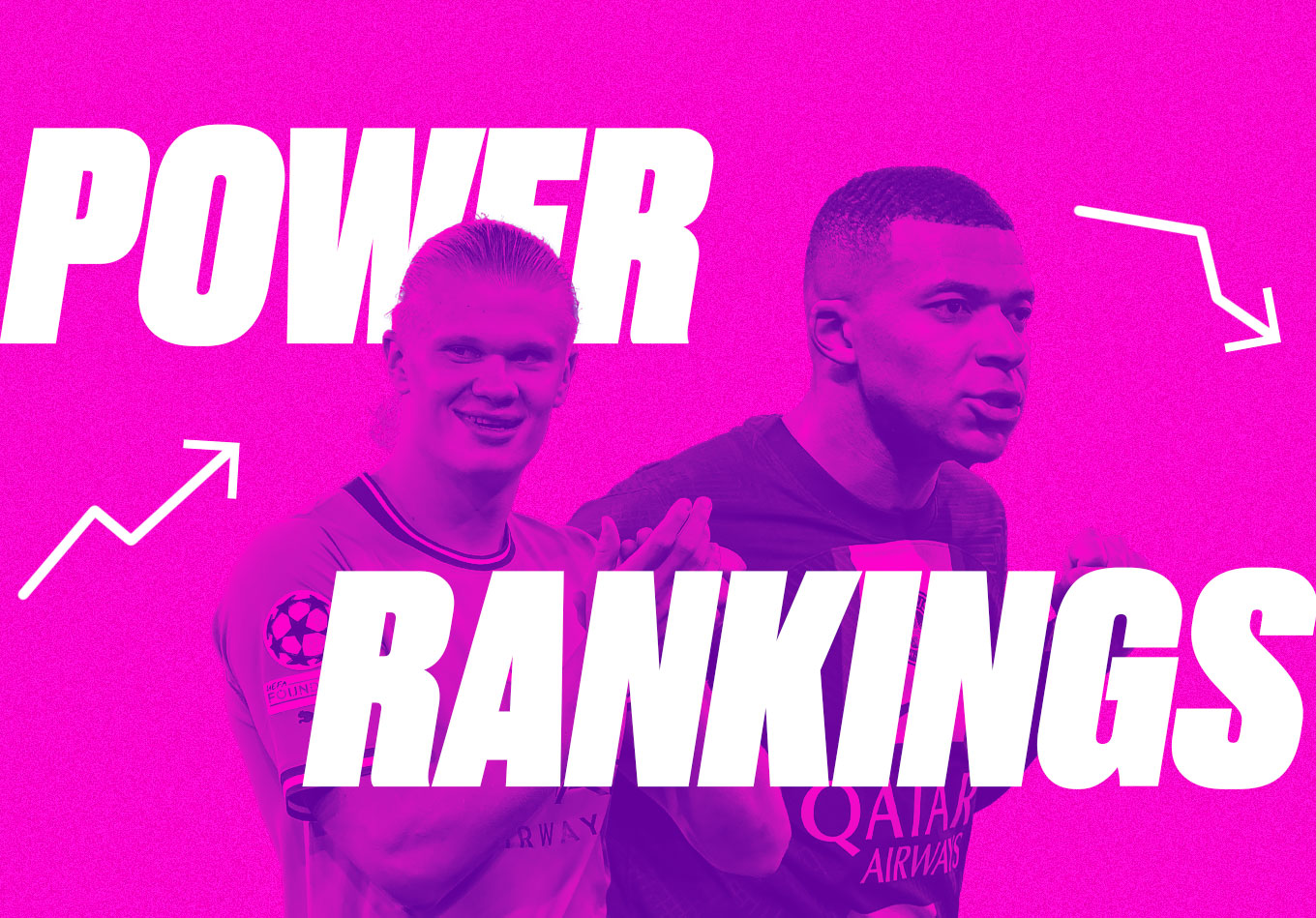Introducing Power Rankings, the new way to tell which club is actually “by far the greatest team the world has ever seen.”
During every transfer window, players move all over the world to their new teams. Between divisions. Between countries. Between continents. Measuring the ability of these teams across the global footballing system is a challenging task.
Comparing teams that play in the same domestic league is somewhat straightforward given the number of times they play one and other, but how do we compare teams that have never played each other and may never do so? How do we know how good Manchester United are compared to Cristiano Ronaldo’s new club in Saudi Arabia, Al Nassr?
We would have to watch an awful lot of football to even begin to understand the quality of each team.
But don’t worry, we’ve now got a model that does all the hard work for you.
What Are Power Rankings?
Opta’s Power Rankings is a global team ranking system that assigns an ability score to nearly 13,500 domestic football teams on a scale between zero and 100, where zero is the worst-ranked team in the world and 100 is the best team in the world. The Power Rankings are updated daily and currently rank teams from 183 different countries and 413 unique domestic leagues, providing a truly global rating system in men’s football.
The latest Power Rankings, as of 24 January 2023, rank Bayern Munich as the best team in the world. Each team is ranked relative to Bayern’s ranking of 100, with Manchester City (98.32) close behind them before a drop to the other teams in the top 10.
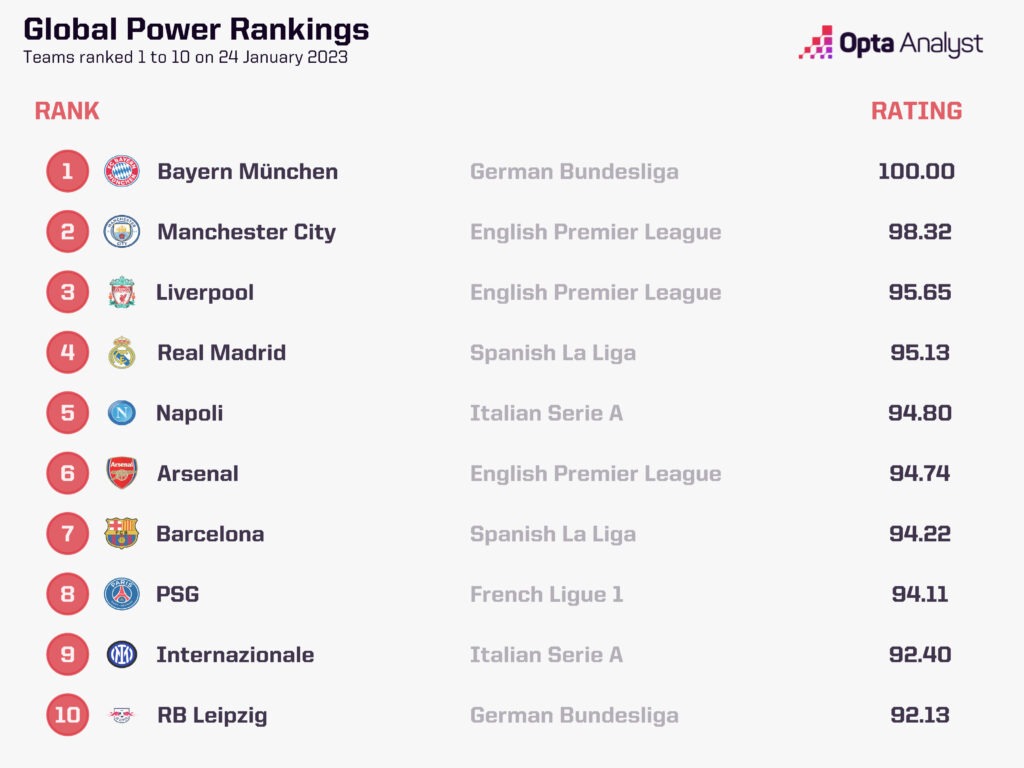
How Can We Use Power Rankings?
Beyond the ability to simply rank or compare teams across the world, Power Rankings can be applied to several different scenarios.
Let’s look at the FA Cup this season. By comparing the relative ability of each team in the Power Rankings, we can quickly find that the underdogs won 31 out of the 106 fixtures in the early FA Cup 2022-23 rounds.
Worcestershire-based and Southern League Premier Division Central team, Alvechurch, recorded the statistically most impressive result with a 2-1 away victory over League One Cheltenham Town in early November. Four divisions and 9,329 global rankings separated the two teams on the day but try telling that to Danny Waldron, Alvechurch’s hero on the day. The magic of the cup lives on.
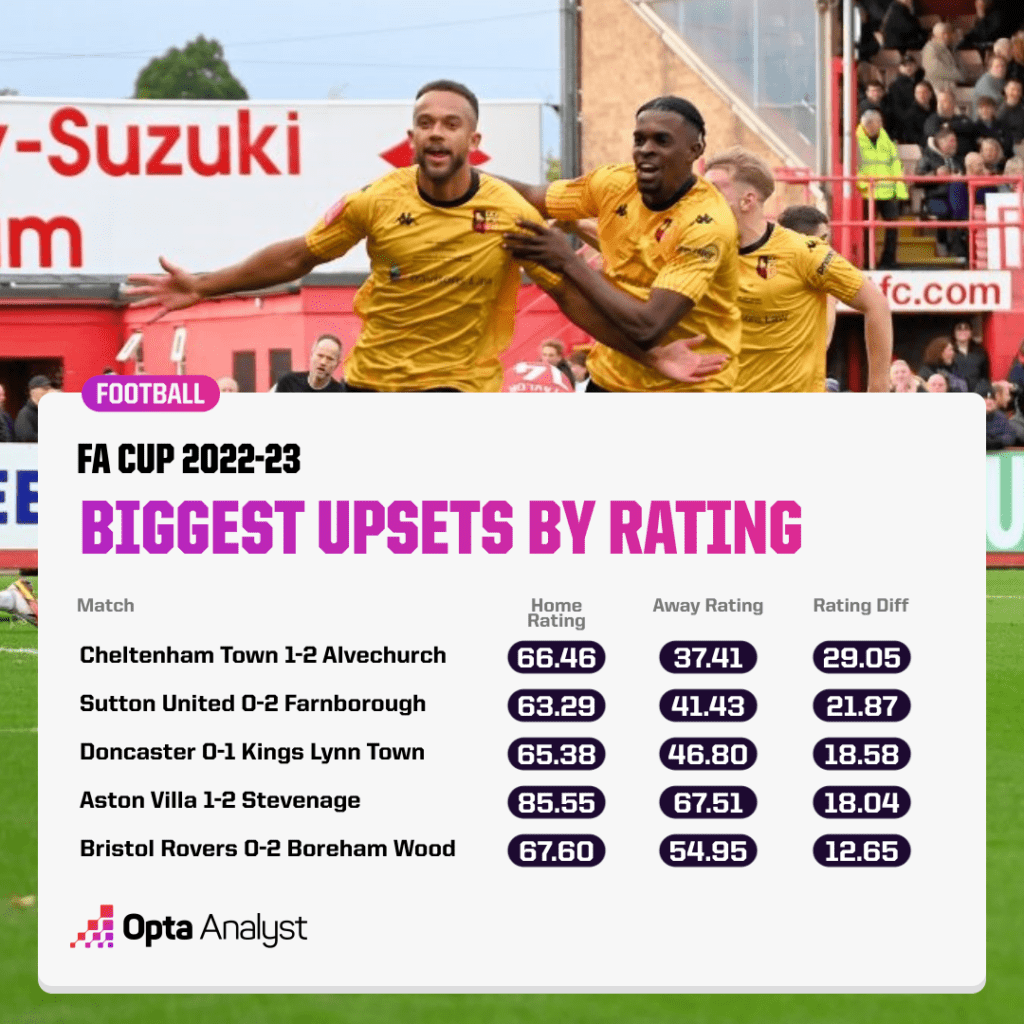
That’s a nice feel-good story but what about a more analytical angle? Power Rankings give us a new way of quantifying the strength of the opposition in a game. We can look at the goals scored by the current top scorers in the big five European leagues and compare the proportion of them that were scored against top-ranked opposition.
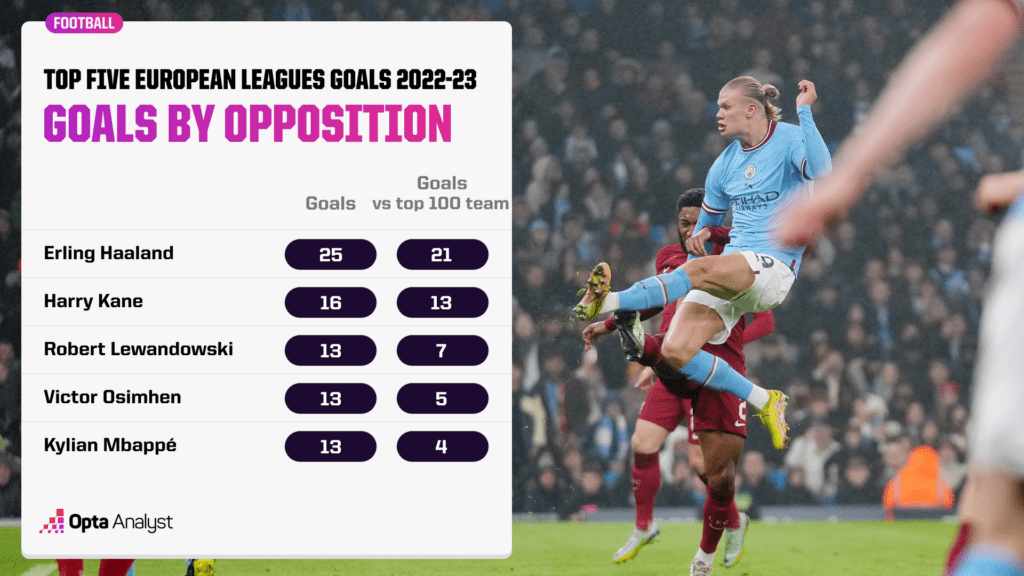
It’s clear to see that the strength of the Premier League is reflected in these numbers with Erling Haaland and Harry Kane scoring a high proportion of their goals against opposition teams that were ranked in the top 100 in the world at the time.
To make it a fairer comparison, we can compare their scoring rates relative to the time they played against teams from both inside and outside the top 100-ranked teams. Despite having fewer minutes to do so, Barcelona’s Robert Lewandowski scores 1.2 goals per 90 against stronger opposition compared to 0.8 goals per 90 against weaker teams, a rate bettered among the top scorers by only Manchester City’s Haaland.
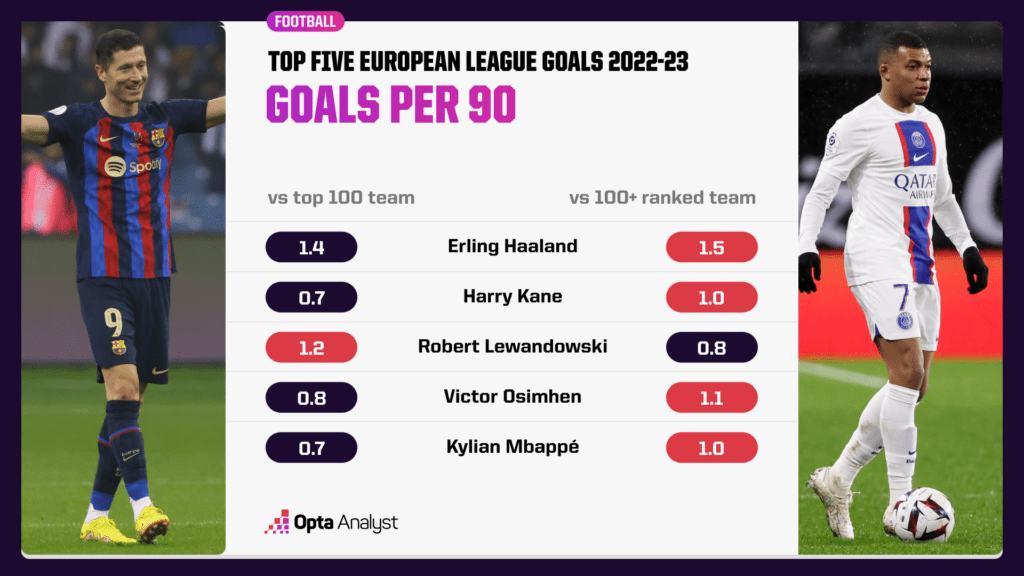
What about a quick way of scouting youngsters around the world?
Few metrics are more powerful than minutes played in football. Managers placing trust in young players that they see in training all week can often give more insight into their ability than a short cameo at the weekend.
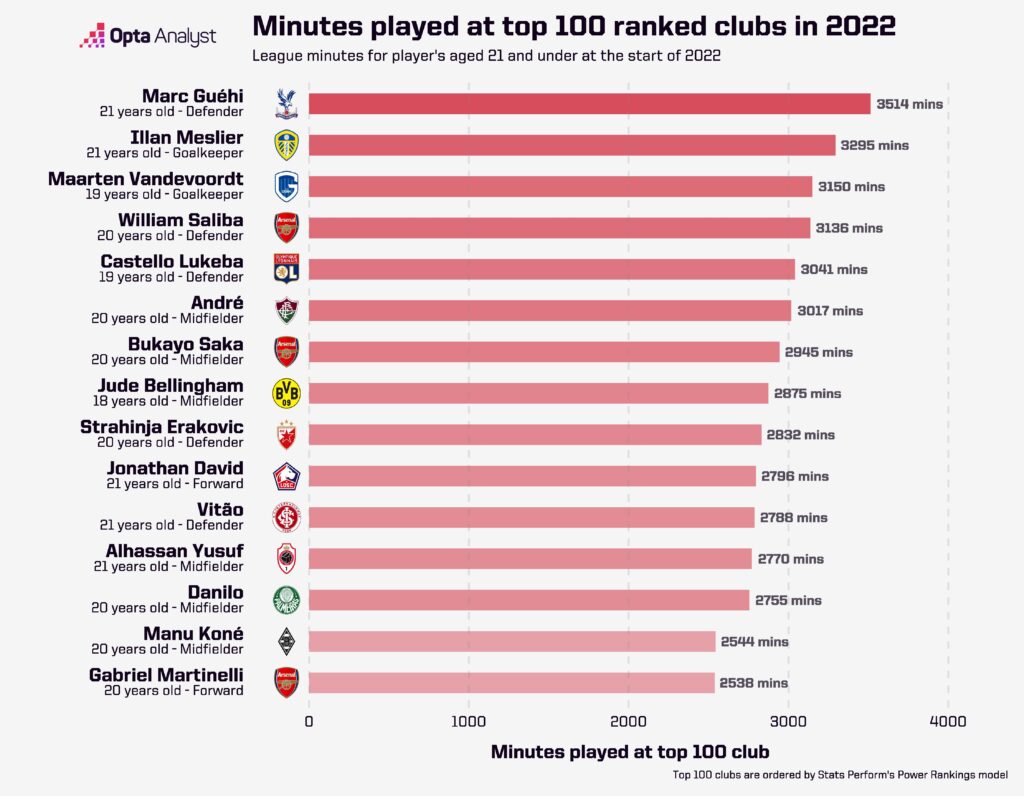
The young players with the most minutes in the 2022 calendar year for teams currently ranked in the top 100 highlights a mixture of names. Some of the more established players you would expect. Others you may not have heard of yet. But lots of players emerge that are highly sought after in the transfer market right now, so it feels like teams are doing something right.
These examples just scratch the surface of what we’re able to analyse with Power Rankings though.
They can be used to compare the quality of different leagues, or to create an exchange rate for metrics if players are transferring between leagues. You could quantify the strength of different Champions League groups. You could see who the most in-form teams are every month. Or maybe how a team or league’s rating evolves over time.
How Do We Calculate Power Rankings?
Now time for the more technical stuff.
Our Power Rankings utilise a hierarchical Elo-based rating system to measure the strength of each team. The Elo rating system is a skill score that has been adapted to many sports since its creation for chess player ratings, including the official FIFA world rankings for both men and women. The Elo algorithm used here analyses match results from over 2,500,000 games since 1990 to assign a rating to each team that is comparable across leagues, countries, and continents.
Elo Rating System
The aim of the system is simple. After each game, rating points are exchanged between the teams depending on the result. Whatever the home team gains in Elo, the away team will lose the exact same value of Elo (or vice versa). If the home team gains 20 Elo points, the away team will lose 20 Elo points.
The difference in ratings between the two teams serves as a predictor for the outcome of a match. Each team’s Elo rating will update on a game-by-game basis based on the likelihood of each team winning and the actual outcome of the match. In simple terms, the following tends to happen:
- If the higher-rated team wins, fewer points will be exchanged.
- If the lower-rated team unexpectedly wins, more points will be exchanged.
- If the match ends in a draw, the lower-rated team will gain a few points.
- The greater the margin of victory, the greater the number of points exchanged is.
- Remember whatever one team gains, the other team loses!
Over the long term, the Elo rating system is self-correcting. A team will gain or lose points relative to their corresponding Elo rating until the ratings reflect their true strength. If a team is undervalued, they will gain more points in each game until their strength is accurately represented by the system.
Let’s look at a hypothetical game between Arsenal and Everton taking place with their respective ratings on 24 January 2023. The team’s individual ratings will change accordingly with each of the following results:
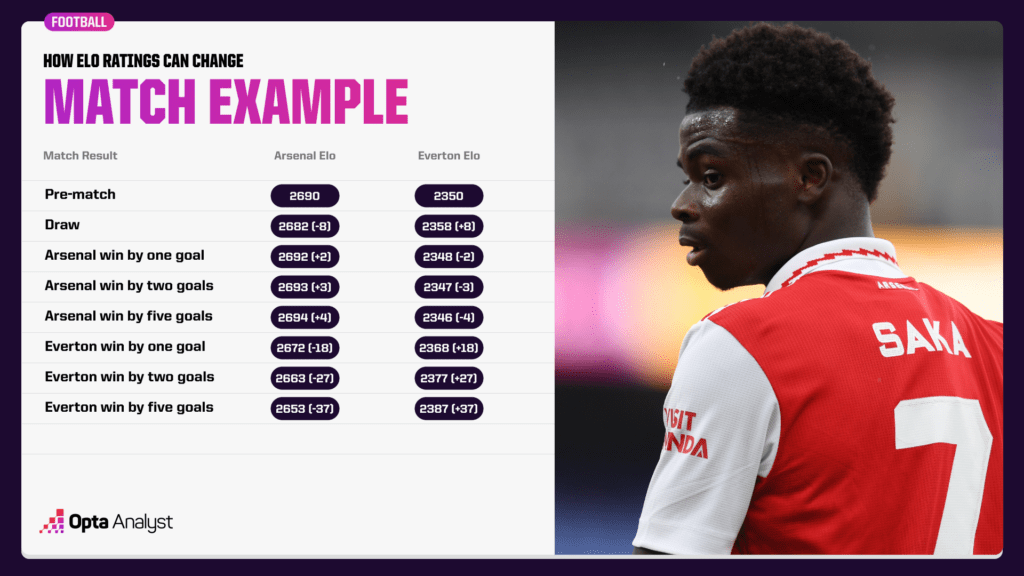
If Arsenal were to lose by a margin of five goals, they could drop as low as ninth in the overall Power Rankings from their current global ranking of fifth. The same result would see Everton rise from 121st to 95th.
Hierarchy Structure
The biggest difficulty with comparing teams globally is that some teams have very little crossover with other leagues and countries. To account for this, we’ve used a hierarchy structure that lets Elo points circulate much quicker. This approach adjusts a team’s rating based on their individual within-league team rating, their league rating, their country rating, and their continent rating. For example, Arsenal’s final Elo rating would be a sum of four separate Elos: (Arsenal, Premier League, England, and Europe).
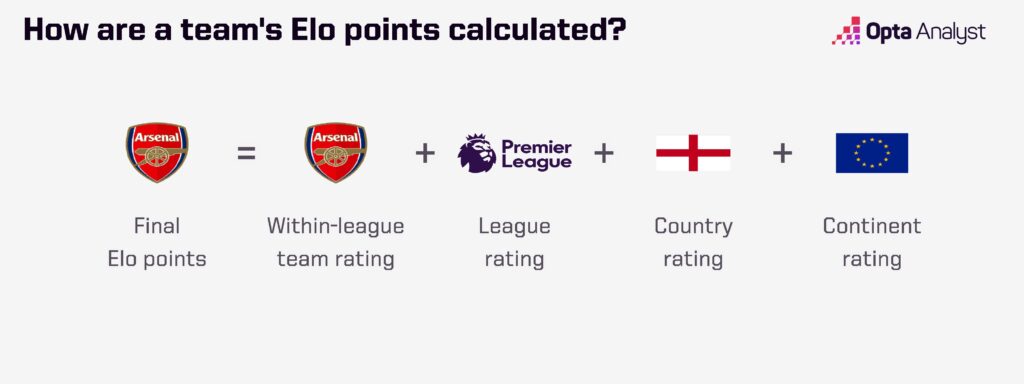
The team level of the hierarchy has it’s Elo adjusted for every game (such as in the hypothetical Arsenal vs. Everton game). However, the other levels are only adjusted when a game takes place between teams in different groups of that hierarchy (e.g., Premier League team vs. Championship team OR English team vs. Spanish team). If a game affects hierarchies other than just the team level, a proportion of the Elo change from the match is applied to the given hierarchy.
We only adjust the highest level of the hierarchy affected by a game (where the lowest level is the league ratings, and the highest level is the continent). For example, if Manchester City (Premier League) played against Vasco da Gama (Campeonato Brasileiro Série A), both teams’ Elo scores would be updated along with the European and South American Elo scores. We do not touch the league or country Elo.
Transformation to Power Rankings
Once we have the underlying Elo ratings, they are then transformed into the Power Rankings. To do this, we use a Power Transformation (we promise this a technical term and totally unrelated to the model’s name) and a min-max scalar to smooth the distribution of the Elo ratings and ensure a fair application of the zero to 100 values, where zero is assigned to the lowest ranked team in the world, and 100 is the highest ranked team.
Summary
Power Rankings provide team ratings across the entire global footballing ecosystem. It allows us to compare teams in different countries or continents to inform decisions on a comparable scale. Who knew that Bangor from the Northern Ireland Intermediate League were as good as Sheikh Russel in the Bangladesh Premier League?
Some of the applications here may seem intuitive but the key is being able to apply them at scale and to automate solutions from both a storytelling and an analytical perspective.
There will always be complexities and nuances when trying to rank nearly 13,500 teams. Leagues with no relegations, statistical outliers within leagues, domestic cup competitions, and new competitions are all examples of new hurdles that we are continuously updating the model for. Bangor will likely never play against Sheikh Russel to truly make the comparison but, for now, this is the most effective way of comparing their levels.
Despite Cristiano Ronaldo’s claims that he wanted to leave Manchester United for a team in the Champions League, he ended up at Al Nassr, who are currently ranked 117th in the world. The lowest-ranked team involved in the Champions League group stages this season were København, currently ranked 114th.
Sometimes things don’t always work out the way we want them to…
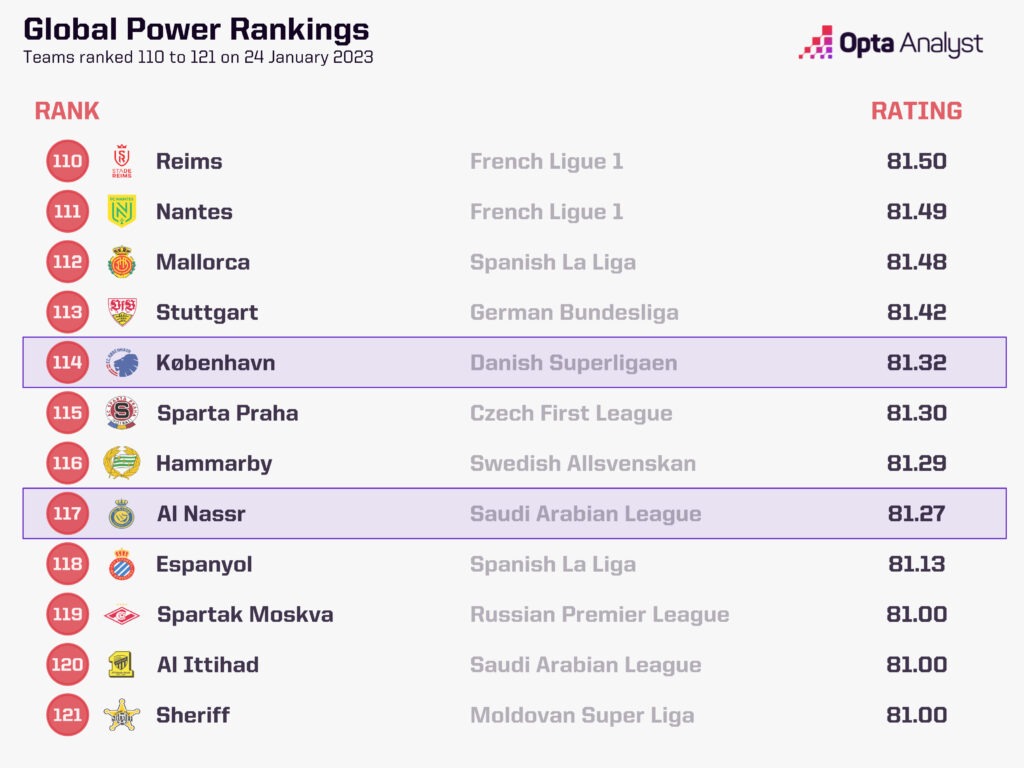
Enjoy this? Subscribe to our mailing list to receive exclusive weekly content.
